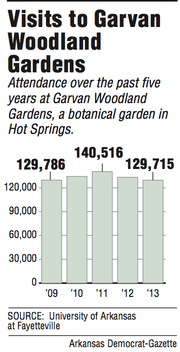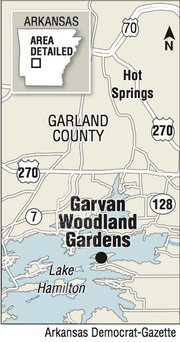Bob Bledsoe described it as a godsend.
"Actually, it was like Christmas morning for me," said Bledsoe, executive director of Garvan Woodland Gardens in Hot Springs.
The University of Arkansas at Fayetteville, which owns the botanical garden, recently cleared a $5.7 million deficit that the garden had built up over several years.
UA eliminated the deficit through an accounting entry, absorbing the hit by reducing the university's available reserve funds. The financial move took place in the fiscal year that ended June 30, but Bledsoe said he first learned of it earlier this month.
The site perhaps best known for attracting visitors with its colorful swaths of tulips and holiday lighting displays has been a part of UA since it was donated as a gift in 1993 upon the death of Verna Cook Garvan. The Arkansas business leader actively planted at the site for decades to make it home to an array of plant life.
The botanical garden is part of UA's Fay Jones School of Architecture, with students and faculty members using it as a "living laboratory," according to the architecture school's website.
UA faculty members learned of the deficit elimination when Chancellor G. David Gearhart briefly mentioned it as part of an informal talk at a Sept. 10 meeting of the faculty senate.
Bledsoe said that when he learned of the financial fresh start, "I told the chancellor and others how thrilled I was."
Garden funding
The garden opened to the public in 2002 and ran at a deficit every year until the most recent fiscal year, according to UA documents and Bledsoe. The garden's cumulative deficit was noted in an audit by the UA System into a multimillion-dollar deficit run up by the Fayetteville campus's Division of Advancement.
The garden's budget for the current fiscal year, which began July 1, is $2.7 million. UA has pledged to provide $300,000 to the garden during this fiscal year and likely will give similar amounts in future fiscal years, said Tim O'Donnell, UA's interim vice chancellor for finance and administration.
Meanwhile, Bledsoe said he will continue to seek regular state funding for the 210-acre site. The garden avoided running at a deficit in fiscal 2014 after receiving about $500,000 from the General Improvement Fund, money Bledsoe credited state Sen. Bill Sample, R-Hot Springs, with obtaining.
"Sen. Sample bailed us out that year," Bledsoe said.
State General Improvement Fund amounts vary from year to year depending on revenue taken in, and many projects compete for those uncertain-amount dollars.
"Whether we get it next year at the end of the session, nobody knows, and it's hard to budget one-time money," Bledsoe said.
He said he wants more consistent funding, noting that the garden has been included in funding requests from the Arkansas Higher Education Coordinating Board. The board will recommend to lawmakers that the garden receive about $500,000 in general revenue over a two-year period beginning July 1, 2015.
Shift in financial helm
The timing of the deficit's clearing came amid changes in UA's financial leadership. Don Pederson in May announced his retirement at the end of the fiscal year. O'Donnell, hired in September of last year as an associate vice chancellor, took over Pederson's role on an interim basis.
Pederson and O'Donnell worked together on recommending use of reserve funds to clear up the deficit, UA spokesman Laura Jacobs said. Gearhart approved the recommendation, she said.
Pederson outlined UA's previous handling of the deficit in a 2013 email obtained through a public disclosure request made under the Arkansas Freedom of Information Act.
"The campus inherited a deficit when Garvan Woodland Gardens was transferred to the campus. Numerous efforts have been made over the years to right-size the annual expenditures realizing that in the startup mode, the annual self-generated revenues would not be sufficient to cover costs," Pederson wrote in response to a question from a UA System auditor.
"Expectations were that the Gardens would become self-supporting including covering prior accumulated deficits although the idea of a subsidy from the campus was not completely ruled out," Pederson wrote in May 2013.
In the past, UA officials "kind of went into the year hoping they would be able to generate sufficient revenue exceeding expenses," O'Donnell said.
An Arkansas Division of Legislative Audit investigative report released last year focused on deficits from UA's Advancement Division, the university's main fundraising arm. However, a simultaneous audit report from the UA System noted that while UA had a written plan for handling the botanical garden deficit in 2004, the deficit had more than doubled from June 30, 2008, to March 31, 2013, reaching nearly $6 million.
For such deficits that are too large to resolve every year, auditors recommended that UA put together a "multiyear resolution."
O'Donnell said the move to eliminate the mounting yearly deficits came about with a realization that "it doesn't look like we'll be able to ultimately get those repaid back from normal operations."
While Jacobs said that was the "primary" rationale for using reserve funds to eliminate the deficit, the auditors' recommendation was also a factor, she said.
Moving past startup
O'Donnell said the deficit was eliminated using UA's central unrestricted net assets, which totaled $21.5 million at the close of fiscal 2014 on June 30.
Yearly visitors to the garden exceeded 130,000 on average for the past five years, a statistic Bledsoe said is heavily dependent on the weather. Admission is $10 for adults.
O'Donnell emphasized that UA continues to support the mission of the garden while seeking to avoid future deficits.
"The charge in going forward -- from all parties here -- is that you guys need to be at a break-even or better scenario," O'Donnell said.
Bledsoe said the garden has been in "a startup" phase, contributing to its financial struggles, even with private donations.
"We have membership, we have facility rentals, we have different sources of revenue that flow in," Bledsoe said, though he called attendance the single biggest source of revenue. Employment fluctuates, with the garden keeping 35-40 workers as part of a staff throughout the year, and that number increasing to more than 50 during peak seasons.
He likened the financial deficits to the growing pains of a teenager.
Now, "it's almost as if the gardens are coming of age," Bledsoe said.
NW News on 09/29/2014

